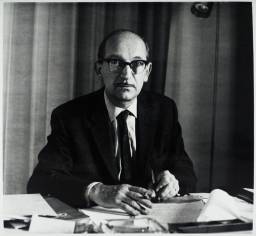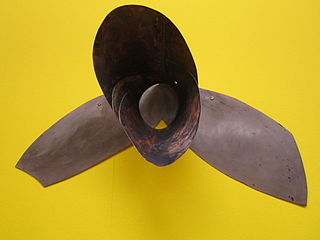
The National is the national art gallery of Scotland. It is located on The Mound in central Edinburgh, close to Princes Street. The building was designed in a neoclassical style by William Henry Playfair, and first opened to the public in 1859.

The National Gallery is an art museum in Trafalgar Square in the City of Westminster, in Central London, England. Founded in 1824, in Trafalgar Square since 1838, it houses a collection of over 2,300 paintings dating from the mid-13th century to 1900. The current Director of the National Gallery is Gabriele Finaldi.

Patrick Joseph Caulfield,, was an English painter and printmaker known for his bold canvases, which often incorporated elements of photorealism within a pared-down scene. Examples of his work are Pottery and Still Life Ingredients.

The Fitzwilliam Museum is the art and antiquities museum of the University of Cambridge. It is located on Trumpington Street opposite Fitzwilliam Street in central Cambridge. It was founded in 1816 under the will of Richard FitzWilliam, 7th Viscount FitzWilliam (1745–1816), and comprises one of the best collections of antiquities and modern art in western Europe. With over half a million objects and artworks in its collections, the displays in the museum explore world history and art from antiquity to the present. The treasures of the museum include artworks by Monet, Picasso, Rubens, Vincent van Gogh, Rembrandt, Cézanne, Van Dyck, and Canaletto, as well as a winged bas-relief from Nimrud. Admission to the public is always free.
The Scottish Colourists were a group of four painters, three from Edinburgh, whose Post-Impressionist work, though not universally recognised initially, came to have a formative influence on contemporary Scottish art and culture. The four artists, Francis Cadell, John Duncan Fergusson, Leslie Hunter and Samuel Peploe, were prolific painters spanning the turn of the twentieth century until the beginnings of World War II. While now banded as one group with a collective achievement and a common sense of British identity, it is a misnomer to believe their artwork or their painterly careers were heterogeneous.

Robert Geoffrey William Anderson, is a British museum curator and historian of chemistry. He has wide-ranging interests in the history of chemistry, including the history of scientific instrumentation, the work of Joseph Black and Joseph Priestley, the history of museums, and the involvement of the working class in material culture. He has been Director of the Science Museum, London, the National Museums of Scotland, the British Museum, London, and president and CEO of the Chemical Heritage Foundation in Philadelphia.
Dame Margaret Kate Weston, DBE, FMA was a British museum curator who was the director of the Science Museum, London, between 1973 and 1986. She began her career as an electrical engineer before joining the Science Museum in 1955. Weston oversaw the expansion of the museum into the Science Museum Group, including the foundation of the National Railway Museum in York and the National Museum of Photography, Film and Television in Bradford. She also played a key role in acquiring Concorde 002, which is now housed at the Fleet Air Arm Museum in Yeovilton.

John Bellany was a Scottish painter.

Sir Robert (Robin) James Philipson RSW was an English-born painter who was influential within the Scottish art scene for over three decades.

Scottish art is the body of visual art made in what is now Scotland, or about Scottish subjects, since prehistoric times. It forms a distinctive tradition within European art, but the political union with England has led its partial subsumation in British art.

The National Museum of Scotland in Edinburgh, Scotland is a museum of Scottish history and culture.

Nathan Coley is a contemporary British artist who was shortlisted for the Turner Prize in 2007 and has held both solo and group exhibitions internationally, as well as his work being owned by both private and public collections worldwide. He studied Fine Art at Glasgow School of Art between 1985 and 1989 with the artists Christine Borland, Ross Sinclair and Douglas Gordon amongst others.

John Ronald Craigie Aitchison CBE RSA RA was a Scottish painter. He was best known for his many paintings of the Crucifixion, one of which hangs behind the altar in the chapter house of Liverpool Cathedral, Italian landscapes, and portraits. His simple style with bright, childlike colours defied description, and was compared to the Scottish Colourists, primitivists or naive artists, although Brian Sewell dismissed him as "a painter of too considered trifles".

Sir Norman Robert Reid was an arts administrator and painter. He served as the Director of the Tate Gallery from 1964 to 1979.

Alison Mary Wilding OBE, RA is an English artist noted for her multimedia abstract sculptures. Wilding's work has been displayed in galleries internationally.

Humphrey Ocean is a contemporary British painter.

Art in modern Scotland includes all aspects of the visual arts in the country since the beginning of the twentieth century. In the early twentieth century, the art scene was dominated by the work of the members of the Glasgow School known as the Four, led by Charles Rennie Mackintosh, who gained an international reputation for their combination of Celtic revival, Art and Crafts and Art Nouveau. They were followed by the Scottish Colourists and the Edinburgh School. There was a growing interest in forms of Modernism, with William Johnstone helping to develop the concept of a Scottish Renaissance. In the post-war period, major artists, including John Bellany and Alexander Moffat, pursued a strand of "Scottish realism". Moffat's influence can be seen in the work of the "new Glasgow Boys" from the late twentieth century. In the twenty-first century Scotland has continued to produce influential artists such as Douglas Gordon and Susan Philipsz.
Richard Edward Ion Calvocoressi is a British museum and gallery curator and art historian.

The City Art Centre is part of the Museums & Galleries Edinburgh, which sits under the Culture directorate of the City of Edinburgh Council. The City Art Centre has a collection which include historic and modern Scottish painting and photography, as well as contemporary art and craft. It is an exhibition based venue with no permanent displays.
Archie Brennan (1931–2019) was a noted Scottish tapestry weaver. He served his apprenticeship at the Edinburgh Tapestry Co and studied at Edinburgh College of Art. He went on to work at the College establishing their department of Tapestry and Fibre Arts. He also served Dovecot as their artistic director.















